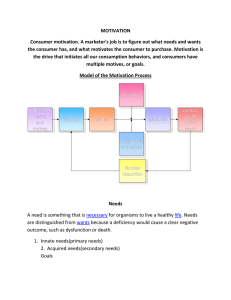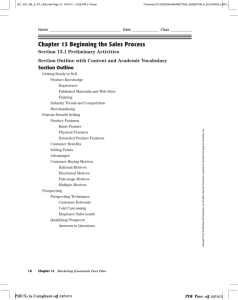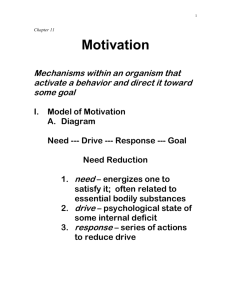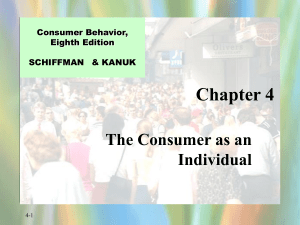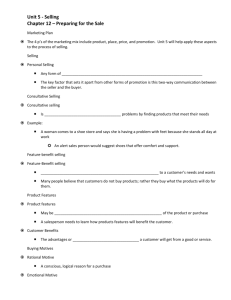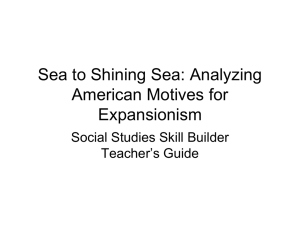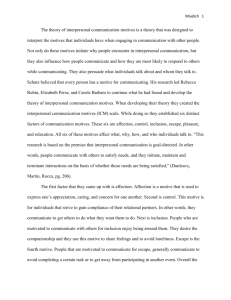Motivation: Theories and Types of Motives
advertisement
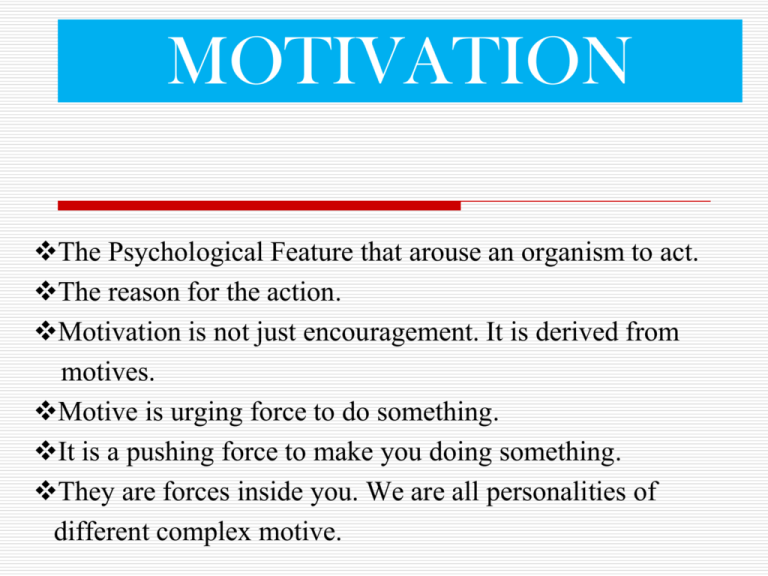
MOTIVATION The Psychological Feature that arouse an organism to act. The reason for the action. Motivation is not just encouragement. It is derived from motives. Motive is urging force to do something. It is a pushing force to make you doing something. They are forces inside you. We are all personalities of different complex motive. MOTIVATION EXAMPLE: A student want to get degree. A lonely person want to make friends. A hungry person want to eat food. A bored person want to enjoy by listening music etc. MOTIVATION These are all small motives. A Person’s personality is reflection of his / her motives. We are unconsciously doing something which we don’t know ourselves; They are un-conscious motives. We can judge the personality of a person by his behavior because his behavior is the reflection of his motive. Otherwise if we know the motive of someone then we can predict his behavior. MOTIVATION EXAMPLE: If I Know that your motive is to be a psychologist then I can predict that your behavior should be something like; Keen in studying psychology books , attending psychology classes regularly and take keen interest in lectures, look everyday examples in the perspective of the psychology etc. MOTIVATION TYPES OF MOTIVES There are mainly three types of Motives. Biological / Psychological / Primary Social / Psychological / Secondary Ludic / stimulation MOTIVATION COMPONENTS OF MOTIVES Need Need arises within yourself. Drive Drive is the state of arousal, the time when you are acting to get your goal, give rise to fulfill your needs Reward Achievement of your goals Satisfaction After getting reward you will become satisfied. MOTIVATION THEORIES OF MOTIVATION These theories try to provide general sets of principles to guides our understanding of the urges, wants , needs, desires, strivings and goals that come under the heading of motivation. There are four theories of Motivation. Drive Theory / Push Theory Incentive Theory / Pull Theory Opponent – Process Theory/ Emotion Theory Optimal Level theory / Just Right Theory MOTIVATION DRIVE THEORY / PUSH THEORY Behavior is pushed towards goal by the driving states within the person or animal. When an internal driving state is aroused, The individual to engage behavior which will lead to a goal that reduce the intention of the driving state. In human beings at least, reaching the appropriate goals which reduce the drive state is pleasurable and satisfaction. The Motivation is said to concept of; MOTIVATION DRIVE THEORY / PUSH THEORY Driving state Goal directed behavior initiated by the driving state. The attainment of an appropriate goal. Reduction of the drawing state and subject satisfaction and relief when goal is reached after a time the driving state builds up against the push behavior toward to appropriate goal. The sequence of events just describes is something called the motivational cycle. MOTIVATION INCENTIVE THEORY / PULL THEORY The theory best apply on your biological motive – hunger, Thirds and six of example. But even here they encounter problems spouse the intense, that we compare the motivate, goal-directed behavior of two groups of rats which have equivalent hunger drives; The rats of both groups have starve for one day. One group is given the very testy food, while the other group get plain food. As you might expect that testy food group -----------------------------------------------. There is something about the goal itself that motives. MOTIVATION INCENTIVE THEORY / PULL THEORY Thus in contrast with the push of drive theories, incentives theory are pull theories of motivation because of certain characteristics they have the goal objects Pull behavior towards them. The Goal objects which motivate behavior are know as incentives. An important part of remaining incentive theory id the individually expect pleasure from the attainment of what are called positive incentives and from the evidence of what are know and negative incentive. MOTIVATION EXAMPLES: You want to buy specific model of a mobile phone for yourself. We went to the market and found that the desired mobile is not available in the market are it is out of your financial rage, and you purchase another mobile set which is not the desire one. Now you may have the feeling of achievement but you have not remain certified with that, because desire was somewhat deferent from the achieve mobile set. MOTIVATION OPPONENT – PROCESS THEORY/ EMOTION THEORY We are motivated to act in the way to get pleasure and to avoid all incidences which give us displeasure. Basic to this theory is the observation that many emotional-motivating states are followed by opposing or opposite states. Most of our emotional feelings are followed by opposite state. MOTIVATION EXAMPLE A Person start talking heroin to get maximum pleasure but when he became used to it then he takes heroine to avoid displeasure. MOTIVATION OPTIMAL LEVEL THEORY / JUST RIGHT THEORY This theory states that we are motivated to have balance state of arousal. If state of arousal is very high or very low then we try to balance it by taking it around or pushing it up. MOTIVATION EXAMPLE: If you are stuck in traffic jam and everyone id honking horn then you will turn off your car cassettes player in order to cut down the state of arousal. If you are home alone, there is load shedding as well, dark all around, telephone is also not working and you are getting bored then your state of arousal will be very low. To boost your arousal you will do some thing to make it balance, either you will take out your car and go for a long drive, or find your walkman to listen some songs.
